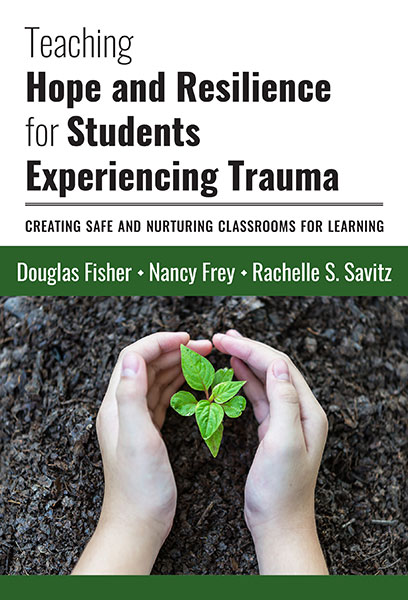Professors: Request an Exam Copy
Print copies available for US orders only. For orders outside the US, see our international distributors.
Douglas Fisher, Nancy Frey, Rachelle S. Savitz
Publication Date: November 15, 2019
Pages: 144

Huge numbers of our students are caught in storms of trauma—whether stemming from abuse, homelessness, poverty, discrimination, violent neighborhoods, or fears of school shootings or family deportations. This practical book focuses on actions that teachers can take to facilitate learning for these students. Identifying positive, connected teacher–student relationships as foundational, the authors offer direction for creating an emotionally safe classroom environment in which students find a refuge from trauma and a space in which to process events. The text shows how social and emotional learning can be woven into the school day; how literacies can be used to help students see a path through challenges; how to empower learners through debate, civic action, and service learning; and how to use the vital nature of the school community as an agent of change. This book will serve as a roadmap for creating uniformly consistent and excellent classrooms and schools that better serve children who experience trauma in their lives.
Book Features:
Douglas Fisher is a professor and chair of the Department of Educational Leadership at San Diego State University and a teacher leader at Health Sciences High and Middle College. Nancy Frey is a professor of educational leadership at San Diego State University and a teacher leader at Health Sciences High and Middle College. Rachelle S. Savitz is assistant professor of adolescent literacy at Clemson University; she received the 2020 Association of Literacy Educators & Researchers (ALER) Jerry Johns Promising Researcher Award.
“In a time where we are more aware and informed on the impact of trauma on learning, brain development, and relational implications, a book such as Teaching Hope and Resilience for Students Experiencing Trauma, by Douglas Fisher, Nancy Frey, and Rachelle S. Savitz, is necessary for instructors at all levels.”
—Teachers College Record
“ Teaching Hope and Resilience for Students Experiencing Trauma will serve as a roadmap for creating uniformly consistent and excellent classrooms and schools that better serve children who experience trauma in their lives.”
—Sir Read a Lot
“The authors’ central vision of a hope-filled school is elegantly simple but never naïve or simplistic. Their many concrete recommendations for practice reveal how that vision might be enacted flexibly, in context-sensitive ways.”
—Kelly Chandler-Olcott, Laura J. and L. Douglas Meredith Professor for Teaching Excellence, Syracuse University
Contents
Introduction: Trauma, Teaching, and Learning 1
Personal Trauma and Its Lasting Effects 2
Trauma and Its Effects on Young People 4
But Past Is Not Prologue 5
The Purpose of This Book 6
1. The Protective Power of Relationships 9
Relationships and Traumatized Youth 10
Teacher–Student Relationships 11
Differential Treatment of Students 13
The Damaging Effects of Humiliation and Sarcasm 14
Interrupt the Pattern 19
Measuring Teacher–Student Relationships Through Warmth and Conflict 21
The Warm Demander 24
Build the Resilience of Students Through Stronger Relationships 25
2. Social and Emotional Learning Is Woven into the Curriculum 29
Identity and Agency 30
Social and Emotional Learning in the Classroom 32
Integrating Identity and Agency 33
Peer Relationships and Social Capital 37
Addressing Bullying and Cyberbullying 44
Suicide Prevention 45
Build the Resilience of Students Through Social and Emotional Learning 50
3. Utilizing Literacies to Maximize Learning 53
The Power of Literature 55
Identity and Literacy Response 56
Literacies as Levers to Maximize Learning for Traumatized Youth 57
Relevance and Triggers 58
Using Discussion for Engaging and Active Dialogue 62
Secondary Trauma and Discussion 62
Empathy Through Reading and Discussion 63
Using Discussion Tools 64
Teachers’ Responses and Disclosures 67
Writing as Catharsis 68
Story Writing with Young Children 69
Writing with Adolescents 70
Locating Appropriate Literature for Reading, Discussion, and Writing 71
Build the Resilience of Students Through Literacies 73
4. Teaching for Empowerment 75
Learner Empowerment and Engagement 77
Empowerment Is Action-Oriented 78
Relational Conditions for Empowerment 79
Choice and Voice 80
Research and Inquiry as Tools for Empowerment 81
Three Kinds of Debate of Controversial Topics 88
Civics Education and Engagement 92
Building Resilience Through Empowerment 96
5. School Communities as Agents of Change 99
The Mask Project 99
Complex Trauma Requires Complex Responses 100
Trauma-Sensitive Schooling 101
Characteristics of a Trauma-Sensitive School 102
A Logic Model for a Trauma-Sensitive School 104
Home-Like Schools Build Resilience Through Change 113
Literature Cited 115
References 116
Index 127
About the Authors 138
Professors: Request an Exam Copy
Print copies available for US orders only. For orders outside the US, see our international distributors.